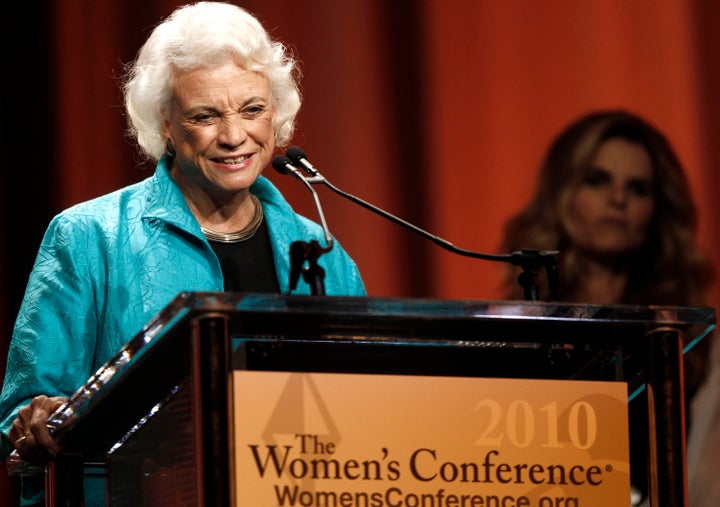
A feminist Jew, a wise Latina woman, and a Harvard Law dean walk into a bar... Thirty years ago, that would have been the opening of what would now be seen as a politically incorrect joke, the bar a place to drink rather than an entry into the practice of law. The idea of having a woman on the Supreme Court was posited as a political strategy by presidential candidate Ronald Reagan's key campaign advisor, Stuart Spencer, in response to late campaign tightening in the polls. After a bitter convention battle between feminists and non-feminists, Republicans had dropped their 40-year support of the Equal Rights Amendment. They were in danger of losing the women's vote in a year when, after six decades of voting in lower numbers, women would come out to vote in numbers equal to men -- the first year in which there would be a significant gender gap in voting, with men overwhelmingly supporting Reagan while women split more evenly.
To fulfill his campaign pledge, President Reagan nominated a relatively unknown Arizona state judge to be his first appointment to the Supreme Court on July 7, 1981. "My nomination was a great surprise to the nation, but an even greater surprise to me," Sandra Day O'Connor has said. She looked not all that different than the typical woman of the time: she wore rose-colored dresses and lavender suits -- with skirts rather than pants, often with a scarf or pearls at her throat. "When I first ran for state legislature," she has said, "it was simply a matter of political reality that, in order to get elected, a woman had to appear and act 'feminine.' People gave up their traditional notions only grudgingly."
She'd graduated Order of the Coif at Stanford but been offered only a job as a legal secretary at California law firms. She spent five years on what would become "the mommy track" when her sons were young; she'd lost her babysitter and couldn't work miracles. When Ken Starr came to her home to interview her for the Court appointment, she served a lunch of salmon mousse salad she'd prepared before he arrived.
Somehow, it's hard to imagine Justices Roberts or Alito or Thomas fixing salmon mousse in preparation for being appointed to the Court. Somehow it's hard to imagine the first woman nominee might have gained the appointment to the Court if she had not.
O'Connor seemed at first blush the kind of person anyone might overlook at the time: an attractive woman who would not make anyone nervous. But she would not be overlooked. In response to an editorial in the New York Times referencing "nine old men" of the Court and using the POTUS/SCOTUS monikers for the President and the Supreme Court that became popularized on "West Wing," she set the paper straight in a letter that displayed her disarming wit:
According to the information available to me, and which I had assumed was generally available, for over two years now SCOTUS has not consisted of nine men. If you have any contradictory information, I would be grateful if you would forward it as I am sure the POTUS, the SCOTUS and the undersigned (the FWOTSC) would be most interested in seeing it.
FWOTSC. First Woman on the Supreme Court.
It's hard to take offense when you are laughing. Not impossible, but a challenge at least.
With her first major decision, in Mississippi University for Women v. Hogan, she began the process of changing the law of gender discrimination. When then lower-court judge Ruth Bader Ginsburg brought the opinion home to show her husband, his response was "Did you write this?" Justice O'Connor became the swing vote on the issue of abortion, allowing a narrowing of Roe v. Wade but refusing to overturn it. "At the heart of liberty is the right to define one's own concept of existence, of meaning, of the universe, and of the mystery of human life," she wrote. She was the swing vote in Price Waterhouse v. Hopkins, finding discrimination had been "a substantial factor" in a decision not to promote a woman to partnership. She was the deciding vote in Jackson v. Birmingham Board of Education, allowing a whistle blower standing to sue for retaliation in gender discrimination circumstances, and in Davis v. Monroe, allowing a girl who'd been subject to relentless sexual taunts by a classmate to sue the school for allowing the hostile environment to go unchecked.
Would the law be different had a man been appointed in her place? The weight of the voting record of other Republican appointees to the Court since 1981 suggests it well might be.
In her first year as Justice, O'Connor received over 60,000 letters, more than any other justice in history. Some were admittedly hostile, one addressed to "Mrs. John O'Connor" urging her to turn down the appointment as unbefitting "a wife and mother who respects the psychological components of a family" and another beginning "Back to your kitchen and home female! This is a job for a man and only he can make the rough decisions." But many came from women and girls writing about what her appointment meant. When O'Connor began law school in 1950, few women had served on any kind of court, but today women comprise 26% of state judges and 22% of the federal courts -- numbers that are too low, but still higher than they have ever been. In 1979, just two years before Justice O'Connor's appointment, only three women had ever served full Senate terms, all of whom had first gained public office either by appointment or through election to fill vacancies left by their husbands; now 17 women fill Senate seats, with two states -- California and Maine -- being represented solely by women. Justice O'Connor's law school class included only a handful of women, and many of the top law schools simply did not admit women; today women law students outnumber men. Role models matter. Opportunities matter. Changes in the law matter.
A feminist Jew, a wise Latina woman, and a Harvard Law dean... In the joke it's always three. On the Court, we might look to a future when prominent news sources talk about the nine wise old women who will seem as probable as those nine old men did for the first 190 years of the Court.

